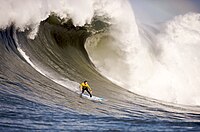
Photo from wikipedia
Abstract In the coastal zone, zooplankton face strong and constant environmental fluctuations that result from interaction between marine and freshwater systems. The aim of this study is to examine the… Click to show full abstract
Abstract In the coastal zone, zooplankton face strong and constant environmental fluctuations that result from interaction between marine and freshwater systems. The aim of this study is to examine the variation patterns of coastal mesozooplankton at short-term scales of days, weeks, and months as well as spring and summer seasons in the vicinity of an estuarine complex to determine the sampling frequency required to obtain a reliable estimate of the community. Sampling was conducted in the surf zone 1-km north and 1-km south of the Tramandai–Armazem estuary channel, Brazil. In total, 108 samples were obtained from October 2015 to March 2016 through horizontal trawls of the sea sub-surface with a plankton net (250 μ m). Environmental parameters were also measured including wind speed, drift current speed and direction, water temperature, salinity, pH, and chlorophyll-a. Spatial and temporal variations in the composition and abundance of the zooplankton community were observed, which were affected mainly by the salinity and current direction. These variations were found to be related to the behavior of the river plume in the region, which was intensified by a strong El Nino influence (2015–2016). The groups making the highest contribution to the observed differences were Mysidae, Cladocera, and Bivalvia, which proves the occurrence of pelagic–benthic coupling. Variation in the abundance of tychoplankton organisms, mainly during spring, was a relevant factor in these differences. To determine the temporal variability, the frequency of zooplankton sampling must be related to the aim of the study and the groups of interest (ecological question). Comparative studies of the zooplankton community among seasons do not require more than one sampling per month. On the other hand, for quantitative studies including tychoplankton and meroplankton at lower temporal scales of months or weeks, a minimum of four non-consecutive samplings should be conducted.
Journal Title: Regional Studies in Marine Science
Year Published: 2019
Link to full text (if available)
Share on Social Media: Sign Up to like & get
recommendations!